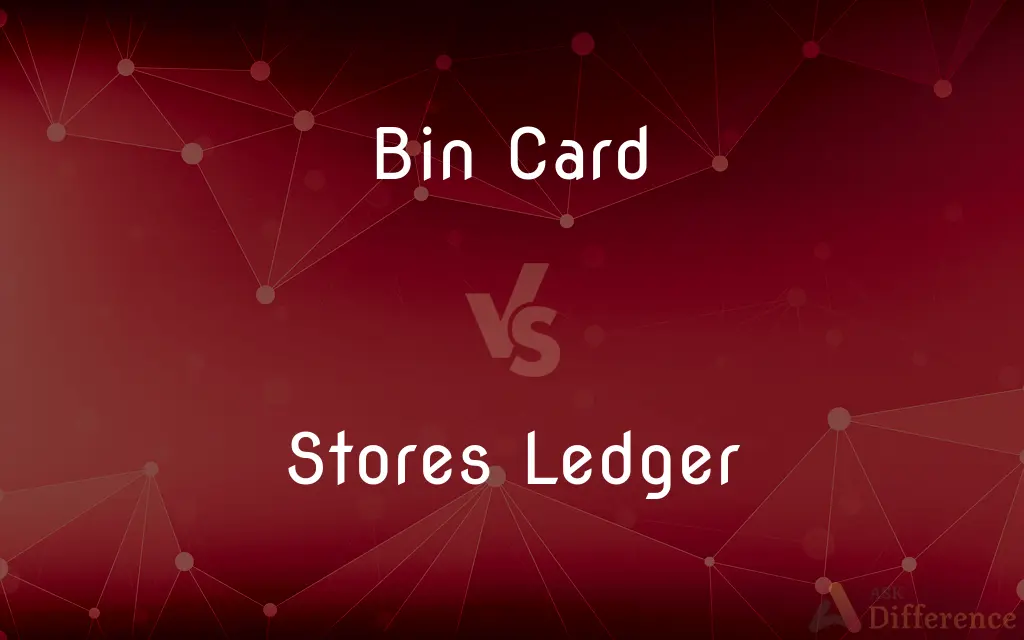Bin Card vs. Stores Ledger — What's the Difference?
By Tayyaba Rehman — Published on December 14, 2023
Bin Card records the quantity of items stored in a bin, while Stores Ledger maintains the value and quantity of stock in a ledger format.

Difference Between Bin Card and Stores Ledger
Table of Contents
ADVERTISEMENT
Key Differences
A Bin Card is a document that keeps track of the number of items held in a specific location, typically a bin or a shelf. In many industries, especially where physical inventory is key, it is crucial to have a record of stock available at a glance. On the other hand, a Stores Ledger provides a detailed record not only of the quantity but also the value of the stock. This ledger offers a broader view of inventory, encompassing both quantity and monetary considerations.
The primary purpose of the Bin Card is to provide instant information about stock quantity in a particular location. Whenever stock is added or removed, the Bin Card is updated to reflect this change. Conversely, the Stores Ledger, while also keeping track of stock movements, places a significant emphasis on the value of inventory, tracking both incoming and outgoing financial impacts of stock transactions.
When it comes to the level of detail, Bin Cards are generally simpler. They highlight the quantity of items, often with minimal additional information. The Stores Ledger, however, is comprehensive. It includes detailed information about stock acquisition costs, selling prices, and often even more intricate financial data related to the stock.
Another distinguishing feature is the location of these documents. Bin Cards are usually placed close to the stock, often attached to the bin or shelf containing the items. This ensures immediate updates when stock levels change. The Stores Ledger is typically kept in an office setting, maintained by the accounts or inventory management department, ensuring the financial aspects of inventory are well-documented and organized.
Comparison Chart
Primary Purpose
Tracks quantity of items in a location.
Records both quantity and value of stock.
ADVERTISEMENT
Detail Level
Simple, focused on quantity.
Comprehensive, includes financial details.
Location
Near stock (e.g., attached to bin).
Office setting, managed by accounts department.
Emphasis
Quantity of items.
Value and quantity of stock.
Associated Transactions
Stock addition or removal.
Stock purchases, sales, and financial impacts.
Compare with Definitions
Bin Card
Bin Card is typically placed near the actual stock.
The manager ensured each shelf had a corresponding Bin Card.
Stores Ledger
Stores Ledger provides detailed financial data related to stock.
The Stores Ledger showed the total cost of last month's stock purchases.
Bin Card
Bin Card allows for immediate stock level changes.
After restocking, he promptly updated the Bin Card.
Stores Ledger
Stores Ledger tracks the financial impacts of stock transactions.
After the sale, the Stores Ledger reflected the reduced inventory value.
Bin Card
Bin Card provides instant inventory updates at a glance.
She quickly checked the Bin Card to confirm available items.
Stores Ledger
Stores Ledger aids in financial analysis of inventory.
Using the Stores Ledger, they analyzed the profitability of their stock.
Bin Card
Bin Card is a document that tracks stock quantity in a specific location.
Every bin in the warehouse has a Bin Card attached.
Stores Ledger
Stores Ledger is managed by the accounts or inventory department.
She submitted the purchase invoices to update the Stores Ledger.
Bin Card
Bin Card simplifies stock management in a physical location.
With a Bin Card system, the warehouse runs more efficiently.
Stores Ledger
Stores Ledger is a comprehensive record of stock quantity and value.
The accountant reviewed the Stores Ledger for monthly inventory valuation.
Common Curiosities
Who usually manages the Stores Ledger?
The Stores Ledger is typically managed by the accounts or inventory management department.
What additional information does the Stores Ledger provide compared to the Bin Card?
The Stores Ledger provides both the quantity and the value of stock, including detailed financial data.
Where is the Bin Card typically located?
The Bin Card is typically placed near or attached to the stock, like on a bin or shelf.
Can a Bin Card also include financial information?
While its primary focus is on quantity, a Bin Card can have basic financial info, but not as detailed as a Stores Ledger.
Why is it important to have both a Bin Card and a Stores Ledger?
While the Bin Card offers quick stock quantity checks, the Stores Ledger provides comprehensive financial data, giving a fuller picture of inventory management.
Can a business operate with just a Bin Card system?
While possible, especially for smaller businesses, they might lack detailed financial insights provided by a Stores Ledger.
What does a Bin Card primarily track?
A Bin Card primarily tracks the quantity of items in a specific location.
Is the Stores Ledger updated as frequently as the Bin Card?
While Bin Cards are updated immediately with stock changes, the Stores Ledger might be updated less frequently, depending on transactions and accounting practices.
Can digital systems replace Bin Cards and Stores Ledgers?
Yes, many businesses now use digital inventory management systems that integrate the functions of both Bin Cards and Stores Ledgers.
Do all businesses use both Bin Cards and Stores Ledgers?
Not necessarily. The use of Bin Cards and Stores Ledgers depends on the business's nature, size, and inventory management needs.
How do sales affect the Bin Card and Stores Ledger?
Sales reduce stock quantity on the Bin Card and also decrease inventory value in the Stores Ledger.
How is the accuracy of Bin Cards and Stores Ledgers ensured?
Regular stock audits and reconciliations between physical stock, Bin Cards, and the Stores Ledger ensure accuracy.
Can a Stores Ledger be used for tax and financial reporting?
Yes, a Stores Ledger provides valuable data for tax and financial reporting due to its detailed record of stock values.
In which settings are Bin Cards most commonly used?
Bin Cards are commonly used in warehouses, stock rooms, and retail settings for immediate stock checks.
How are discrepancies between the Bin Card and Stores Ledger addressed?
Discrepancies are addressed through reconciliation, stock counts, and reviewing transaction records to pinpoint errors.
Share Your Discovery

Previous Comparison
Cisco SNT vs. Cisco SNTP
Next Comparison
Intracellular Digestion vs. Extracellular DigestionAuthor Spotlight
Written by
Tayyaba RehmanTayyaba Rehman is a distinguished writer, currently serving as a primary contributor to askdifference.com. As a researcher in semantics and etymology, Tayyaba's passion for the complexity of languages and their distinctions has found a perfect home on the platform. Tayyaba delves into the intricacies of language, distinguishing between commonly confused words and phrases, thereby providing clarity for readers worldwide.












































